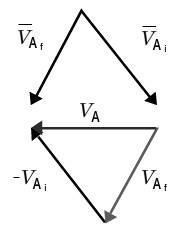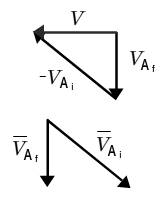
In the space provided, draw separate arrows representing the direction of the change in momentum vector of object A in the two experiments.
Direction of

Is the magnitude of the change in momentum of object A in experiment 1 greater than, less than, or equal to that in experiment 2? Explain.
The change in magnitude of the object
Explanation of Solution
Introduction:
Momentum has both magnitude as well as direction because it is a vector quantity. It is calculated by using the product of mass and velocity of object during motion. The total system’s momentum is equal to the vector summation of the individual momentum.
The change in momentum is given by product of mass and the change in velocity.
For experiment
The change in momentum is given by:
Thus, the direction of motion is along the velocity direction.
Therefore,
The change in momentum vector for experiment

For experiment

Magnitude of velocity vectors from both resultant velocity vectors:
Therefore, The change in object ‘s momentum for experiment
Conclusion:
The change in object’s momentum for experiment
Want to see more full solutions like this?
Chapter 17 Solutions
Tutorials in Introductory Physics
Additional Science Textbook Solutions
Introduction to Electrodynamics
College Physics
Essential University Physics (3rd Edition)
The Cosmic Perspective
Life in the Universe (4th Edition)
Physics (5th Edition)
- Part A The two spheres A and B each have a mass of 400 g. The spheres are fixed to the horizontal rods as shown in (Figure 1) and their initial velocity is 2 m/s. The mass of the supporting frame is negligible and it is free to rotate. Neglect the size of the spheres. If a couple moment of M = 0.9 N m is applied to the frame, determine the speed of the spheres in 3 s. Express your answer to three significant figures and include the appropriate units. Figure M -0.3 m -0.3 m- B 1 of 1 HÅ ? v= Value Units Submit Request Answer < Return to Assignment Provide Feedbackarrow_forwardPart A: Determine velocity of A after collision. Express your answer in terms of v. Enter positive value if the velocity is directed to the right and negative value if the velocity is directed to the left. Part B: Determine velocity of B after collision. Express your answer in terms of v. Enter positive value if the velocity is directed to the right and negative value if the velocity is directed to the left Part C: Determine velocity of C after collision. Express your answer in terms of v. Enter positive value if the velocity is directed to the right and negative value if the velocity is directed to the left Part D: Determine velocity of D after collision. Express your answer in terms of v. Enter positive value if the velocity is directed to the right and negative value if the velocity is directed to the left.arrow_forwardA car travels along a curving road from A to B to C as shown in the figure to the right. a. On the diagram, draw two arrows, one representing the instantaneous momentum of the car at B (label it pg) and the other representing the instantaneous momentum of the car at C (label it B b. Find the direction of the car's change in momentum Ap from B to C using graphical vector operationsarrow_forward
- Consider a cylindrical container of height "h" containing liquid of density ρ full to the brim. Now, a small hole is made on the side of the container at a depth "d" from the top. Calculate the range of the projectile.•Don't copy from other sources.•Don't use TORICELLI'S LAW directly. If you copy you are not a expert thenarrow_forwardConsider a cylindrical container of height "h" containing liquid of density ρ full to the brim. Now, a small hole is made on the side of the container at a depth "d" from the top. Calculate the range of the projectile.•Don't copy from other sources.•Don't use TORICELLI'S LAW directly.arrow_forwardA 0.2 kgkg plastic cart and a 20 kgkg lead cart can both roll without friction on a horizontal surface. Equal forces are used to push both carts forward for a distance of 1 mm, starting from rest. After traveling 1 mm, is the momentum of the plastic cart greater than, less than, or equal to the momentum of the lead cart? Match the words in the left column to the appropriate blanks in the sentences on the right.arrow_forward
- Two identical masses are released from rest in a smooth hemispherical bowl of radius R, from the positions shown in (Figure 1). Ignore friction between the masses and the Part A surface of the bowl. If the masses stick together when they collide, how high above the bottom of the bowl will they go after colliding? Express your answer in terms of R. h = Figure Rarrow_forwardConsider a cylindrical container of height "h" containing liquid of density ρ full to the brim. Now, a small hole is made on the side of the container at a depth "d" from the top. Calculate the range of the projectile. • Don't copy from other sources and explain the answer properly!• Don't use TORICELLI'S LAW directly • All the Bestarrow_forwardPROBLEM 1 Car B is travelling east with a speed of 30 m/s with an acceleration of 2 m/s², while car A is travelling north with a speed of 20 m/s. At t=0, the two cars are 2 km apart as shown in the figure below. a) Calculate the required acceleration of car A so that both cars collide at the origin of the shown coordinate frame b) At what time t does the collison take place ? 30 m/s 2km 20 m/s →X b)arrow_forward
- Part C Also, find the vertical reactions at the rollers B. Express your answer to three significant figures and include the appropriate NB = 4 Value Units ?arrow_forwardDisplayed to the right are two carts connected by a cord that passes over a small frictionless pulley. Each cart rolls freely with negligible friction. Consider the mass of the cart to be m1 and the angle the first cart sits on to be θ1, while the mass of the second cart as m2 and the angle it sits on to be θ2. a)Considering the positive x direction to be pointing as it is in the image, write an equation for the acceleration that the two blocks experience in terms of the mass of the first block m1, the angle θ1, the mass of the second block m2, the angle θ2, and the acceleration due to gravity g. b) What is the equation for tension in regards to the rope coming from the second block? Answer in terms of the mass of the block m2, the acceleration due to gravity g, the angle θ2, and the acceleration of the blocks found previously a.arrow_forwardA 65 kg person running at 2.0 m/s jumps onto the skim board at right. The skim board is 50 cm wide and 120 cm long, with an area of 0.60 m². Part A Draw a sketch of this situation. Part B If the person jumps onto the board on sand with a coefficient of friction of f=0.50, what force will resist the forward movement of the board [N]? Recall the friction force is the normal force times the coefficient of friction. Part C Now assume the person jumps onto the board on a 0.50 cm film of fresh water at 30°C. Use Newton's law of viscosity to estimate the force resisting the forward movement of the board.arrow_forward
 Principles of Physics: A Calculus-Based TextPhysicsISBN:9781133104261Author:Raymond A. Serway, John W. JewettPublisher:Cengage Learning
Principles of Physics: A Calculus-Based TextPhysicsISBN:9781133104261Author:Raymond A. Serway, John W. JewettPublisher:Cengage Learning
